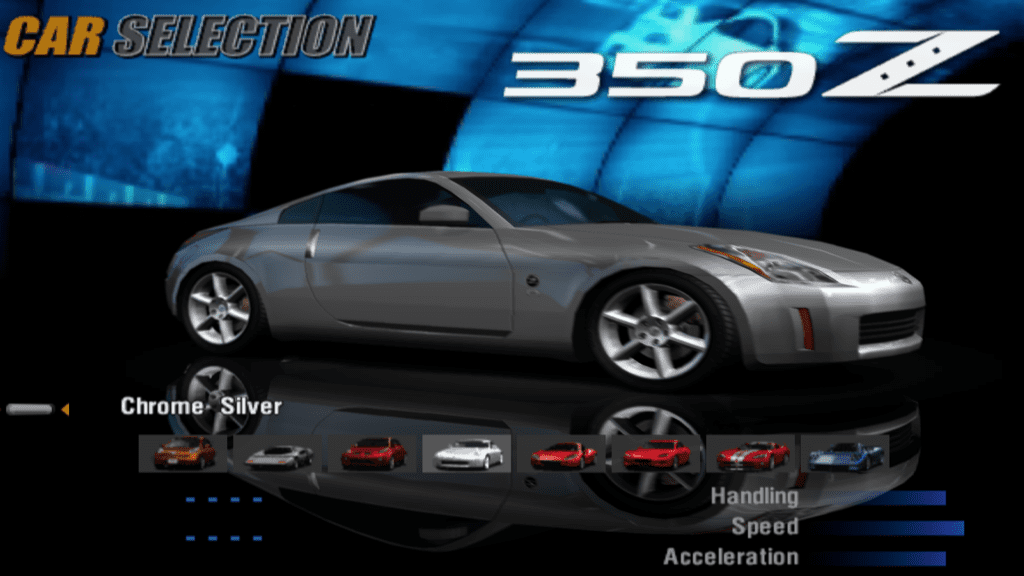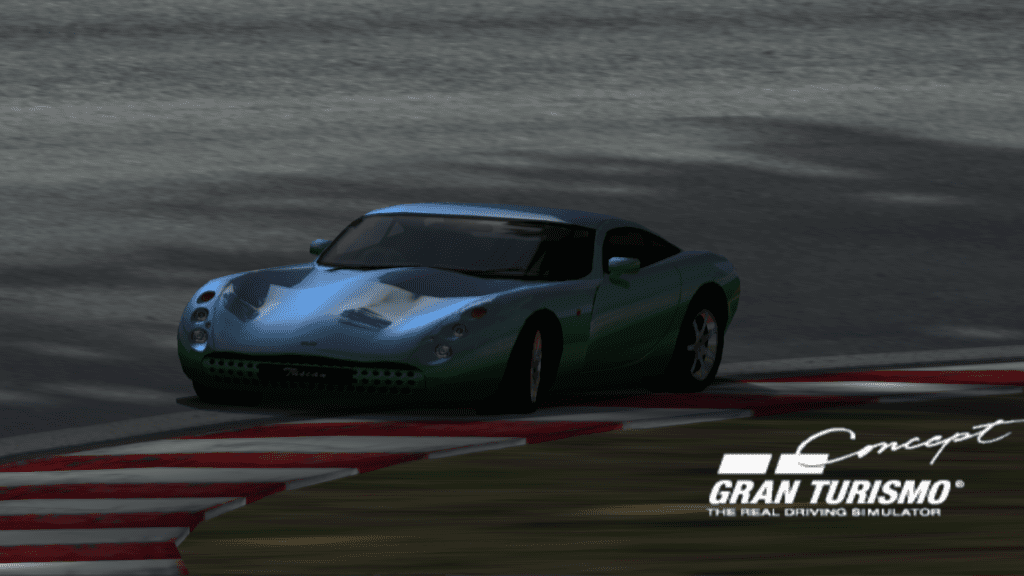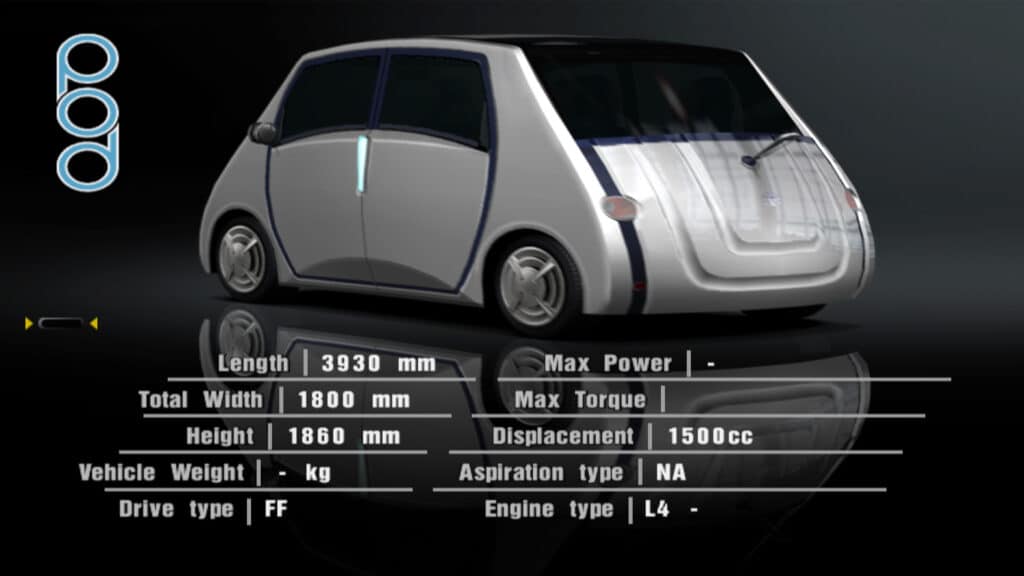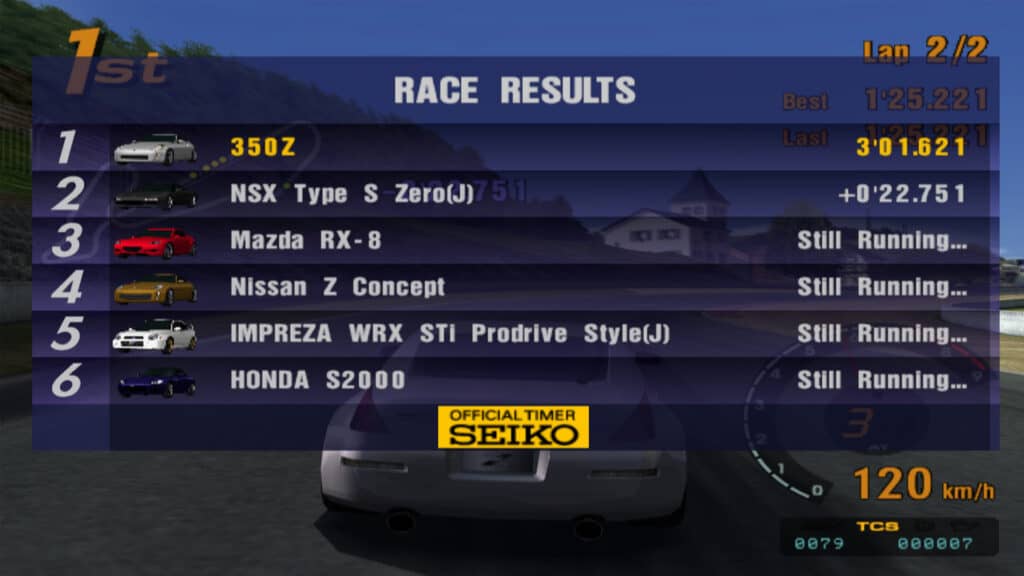Gran Turismo is widely seen as a serious, no-compromise racer where series creator Kazunori Yamauchi ploughs an absurd level of effort into re-creating detailed cars and tracks.
But it’s also known for allowing players to bounce along the surface of the moon in a Lunar Rover.
With this juxtaposition in mind, in 2002 developers Polyphony Digital made the rather unusual decision to release a pared-down version of GT between main entries Gran Turismo 3: A-Spec (GT3) and Gran Turismo 4, as a celebration of the concept cars from the 2001/2 Tokyo and Geneva motor shows, calling it Gran Turismo Concept 2002 Tokyo-Geneva.
Actually, that’s not completely true.
It was originally intended to be a Japan-only release, namely 2002’s Gran Turismo Concept 2001 Tokyo. It was only set to feature cars from the Tokyo motor show but sold so well developers Polyphony Digital decided to update it to include cars from the Seoul Motor Show and make it available for sale in Korea too.
This later extended to Europe with Geneva Motor Show content – the Tokyo-Geneva version – selling over 1.5 million copies worldwide, with one million of those in Europe alone.

Seemingly designed as a PlayStation 2 stopgap between Gran Turismo 3 & Gran Turismo 4, critics were quick to pounce on its lack of content compared to its relatively high price – £25.
Gran Turismo Concept (GT Concept) forms part of Polyphony Digital’s other secondary release collection, joining 2003/4’s Gran Turismo 4 Prologue, Gran Turismo HD Concept from 2006, and 2007’s Gran Turismo 5 Prologue.
GT Concept is perhaps the most limited paid-for release of those mentioned– Gran Turismo HD featured less content but was free to download for the PlayStation 3.
With its 20th anniversary approaching, and the release of Gran Turismo 7 creeping ever closer, we thought now would be a great time to have a look back at Gran Turismo Concept (GT Concept) and ask if the criticism was really deserved?
And we absolutely need to talk about the Toyota Pod too.
Conceptual art
When you think about it, it makes complete sense for GT to create a game based on vehicles displayed at motor shows. After all, GT has been the genre leader in accurate car modelling for a number of years, and a heavy emphasis is placed on admiring the shiny contours of your chosen car.
Take the Scapes mode as an example; high-detail vistas to place your car in and show it off in its best light. The photo modes in GT in general work as a way to look at your car in-game in exquisite detail using real-life photography techniques.
GT’s first photo mode appeared in GT4, so GT Concept just missed out. In many ways it would have been the ideal game to showcase this feature.

Has your Peugeot 206 gotten a little dirty after a Sunday Cup battle with a Mazda Demio? Take it to the in-game Car Wash so it regains its shine. Maybe give it an oil change while you’re there…
In the same way, motor shows are (were?) a chance for manufacturers to show off their cars in the best possible way. Hours are spent by detailing teams on cleaning, polishing and waxing vehicles to the nth degree until they’re more carnauba wax than car.
Collecting cars
GT has long been seen as the ultimate car collector simulator. With hundreds of vehicles to choose from, the quantity, quality, and sheer variety of cars available to players is a huge selling point for the series.
However, GT Concept’s car count was significantly less than its predecessor GT3 on 180 cars and its successor GT4 with over 700 cars. With a car count coming in at around 80. With a fair portion of these being concept cars unlikely to be made available for public sale, it made the experience less thrilling.

Players could drive made-up cars in Ridge Racer, but the USP of the GT series was being able to drive real, tangible cars you could buy in real life.
That’s not to say ‘normal’ cars were absent from the game, there were still a fair smattering of common European and Japanese hatchbacks; Minis, Peugeots and Clios all mixed with Japanese Super GT cars, rally cars and supercars. It was an eclectic mix.
From concept to reality
Content-wise then, GT Concept was found lacking. In terms of tracks, there are only five to choose from – Tahiti Maze, Tokyo R246, Swiss Alps, Midfield Raceway (one of my personal favourites) and the Autumn Ring. These circuits had their reversed versions too, bringing the total track list up to 10.
Strangely, two of the five are rally courses, and most of the cars in the game were incapable of driving off-road, immediately cutting players’ possibilities. Odd.
Graphics received a mild coat of polish, (or should that be carnauba wax?) but GT Concept essentially looked similar to GT3. The same can be said for the sounds, whatever your opinion on GT’s aural delights at this time…

One thing that hadn’t changed, however, was the way GT Concept felt to play. Car handling was still genre-leading, and players coming directly from GT3 would feel instantly at home chucking around their showroom-ready racers.
Even now, the cars have a ‘heft’ about the way they handle. They don’t feel twitchy, and slides can be controlled quite satisfyingly. Four-wheel drifts on the rally stages are easy to pull off too, albeit made easier by how bizarrely wide the rally courses are.
It does feel as though GT Concept is like the Arcade Mode from a full GT release. There’s a small number of cars, short races and fun handling. Perhaps not enough to satisfy the hunger of players after the main course of GT3.
That’s why I’m easy. Easy like Sunday… Cup
Aside from the lack of cars and tracks, the real flaw with GT Concept was how easy it was. Realistically, there were only a few hours of content there for the experienced racing game fan, in stark contrast to its predecessor.
There were only ten race events – each of the five tracks plus its reverse version –with Normal and Professional level events to complete. Plus ten Course License tests. And that’s it.
Thank goodness, then, for the Toyota Pod races…
The Toyota Pod concept car appeared at the 2001 Tokyo Motor Show and was jointly created by Sony and Toyota. It was an attempt to build a car that used advanced AI systems to exhibit the emotions of the driver, displayed via LED lights on the front of the car.
We wrote about it recently as an example of GT’s weird and wonderful cars through the years.
Orange lights represented a happy driver and car, blue meant unhappy, and red intonated there was a fully-paid up nutter behind the wheel. The car even had a tail-like appendage at the rear that wagged if the car was driven particularly well. Hilarious.

The races for the Pod were quite charming, the player battling against five other identical Pods on a short, chicane-filled course that featured a stop zone followed by a big jump. It was a strange affair all-round, but the little sad or excited noises the Pods made was quite endearing – another example of the GT series’ off-beat tendencies.
The Pod races could only be unlocked after 100% completion, which seems a strange decision as they’d have been a good way to break up the rather monotonous Course License and Single Races.
Pay On Demand
Today, a game like this wouldn’t exist. It would be a cheaper DLC pack instead. This is a bit of a shame as we’ll probably never see its like again. On the other hand, GT Concept is a game that does a lot of things right, and for ardent fans of Gran Turismo was worth picking up.
Polyphony Digital acknowledged the absence of content in GT Concept, stating at the time: “We have deliberately narrowed down the number of recorded vehicles and courses to serve as a guide for beginners, creating an environment that is easy to play.”
I take this to mean they focused purely on the driving experience of the game, which was admittedly well sorted after GT3. It’s hard to argue that the driving model doesn’t feel good, but gamers demanded more than a few hours’ entertainment for £25, especially as GT Concept came only a year after GT3.

I’ll finish this GT Concept retrospective with some final thoughts from a Toyota Pod:
Lack of content = red face.
Something like this will never be released physically again = blue face with tears.
Gran Turismo’s handling model and attention to detail = orange face.
Wags tail





Chat with the Community
Sign Up To CommentIt's completely Free